In today’s environment, businesses with large parking lots—particularly those in the automotive industry such as dealerships, fleet vehicle operations, or service centers—face increased exposure to auto crime. With vehicles sitting unattended for long stretches of time, often in open lots and sometimes in low-visibility areas, these properties become prime targets for theft, vandalism, catalytic converter removal, and other costly criminal activities.
The consequences of auto crime go far beyond the immediate cost of damage or loss. Reputational damage, increased insurance premiums, disruptions to daily operations, and the potential for legal liability all underscore the critical importance of proactive security measures. For business owners and property managers, protecting a lot filled with vehicles isn’t just a concern—it’s a strategic necessity. In fact, in today’s data-driven world, a single incident caught on video and shared online can go viral, damaging the brand image of even the most reputable businesses. Commercial security is no longer a back-of-mind expense; it is an essential pillar of business continuity and customer trust.
Understanding the Scope of Auto Crime on Commercial Properties
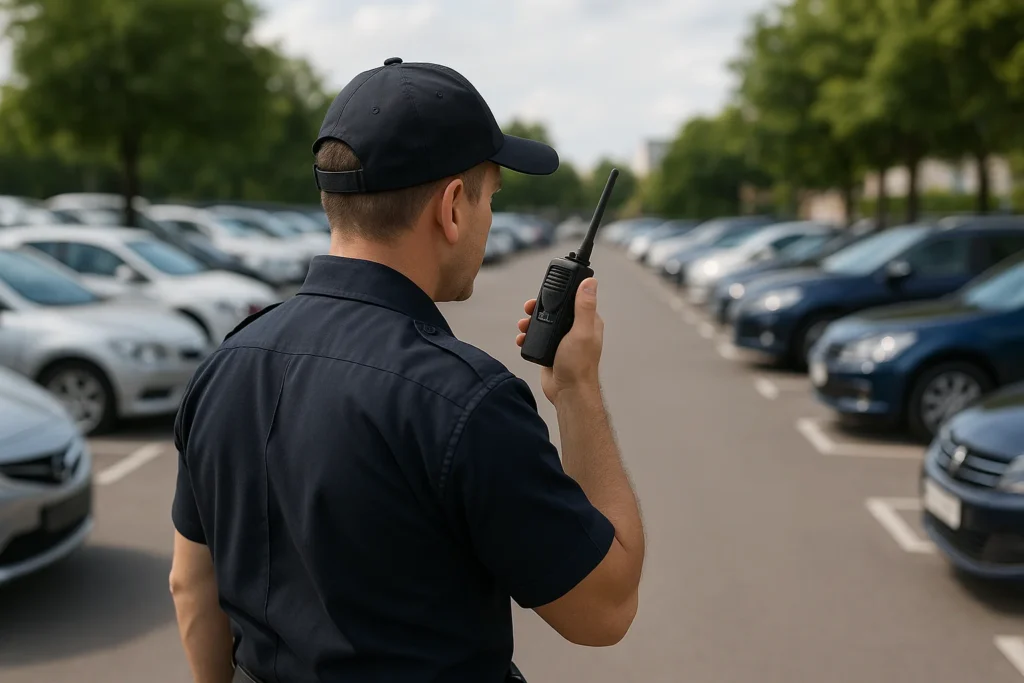
Auto crime on business properties includes a range of threats: from petty vandalism and theft of contents inside vehicles to full vehicle theft and component stripping. One of the most notable surges in recent years has been the theft of catalytic converters due to the value of metals such as platinum and palladium. These parts can be removed in under two minutes, making them an easy target if no surveillance or deterrent is in place.
Car dealerships and automotive storage lots are particularly vulnerable because they typically store numerous high-value vehicles in relatively close proximity. Criminals often case these properties in advance, studying the security infrastructure and identifying weaknesses. Once a pattern is found—such as inconsistent patrols, dark corners, or predictable access—they act quickly and decisively.
The situation is further complicated by economic downturns or spikes in commodity prices. A sudden rise in metal prices, for instance, often corresponds with waves of converter theft. Similarly, hard-to-find parts or certain makes and models of vehicles can attract targeted thefts for illegal resale or black-market exports.
In urban centers and industrial zones, lots that are not actively monitored overnight are often viewed as soft targets. Organized crime rings in particular are known to strip cars for parts or export stolen vehicles within hours of theft. This level of sophistication requires an equally sophisticated approach to prevention. Business owners must recognize that this is no longer the realm of opportunistic petty crime; it is organized, tactical, and evolving.
Investing in Surveillance and Security Infrastructure
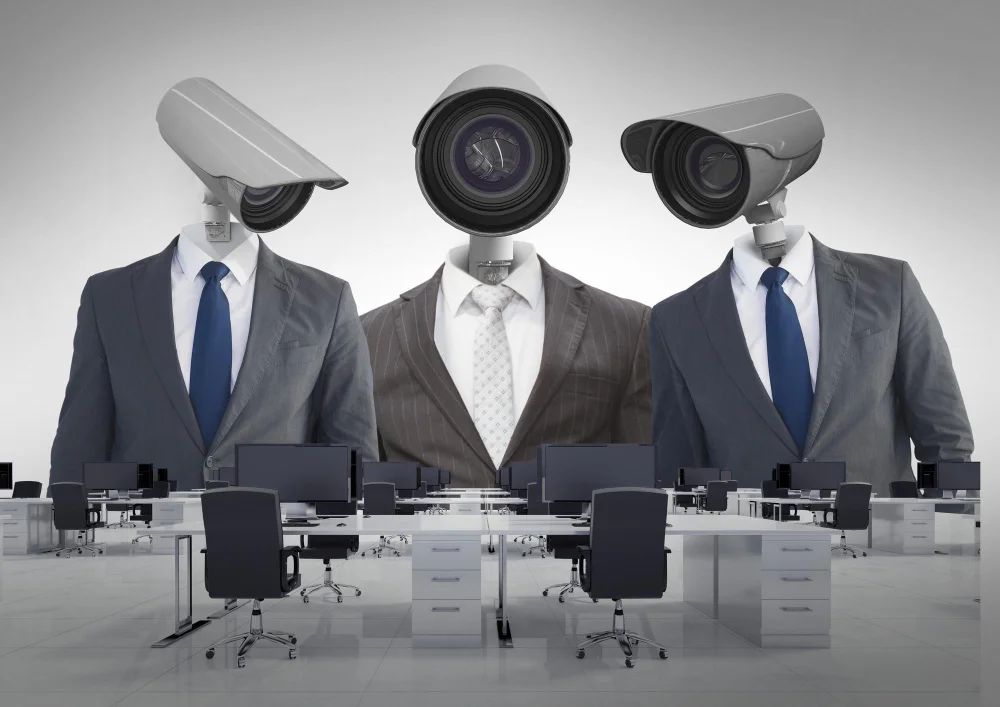
Modern surveillance is far more than just mounting a few cameras. For a parking lot to be effectively protected, a comprehensive surveillance system should include high-resolution cameras with wide coverage angles, infrared night vision, motion detection, and ideally, live monitoring. Cameras should be positioned at all entry and exit points, at key vehicle rows, and on the perimeter facing outward.
Many businesses make the mistake of installing cameras but never checking or maintaining them. Dead zones or faulty equipment can turn your system into a false sense of security. Regular maintenance and testing are essential. Cloud-based video systems with AI analytics can also detect unusual behavior patterns, such as people loitering or vehicles moving at odd hours, and send real-time alerts to security teams.
Some of the most forward-thinking businesses are even integrating thermal imaging and drone technology for nighttime surveillance. Drones can provide mobile, bird’s-eye views of the lot and respond faster than a human patrol, especially in large areas.
In addition to cameras, proper fencing and gating can be critical. Access-controlled entry points reduce the chance of unauthorized visitors, while bollards, spike strips, and retractable gates can stop vehicle theft in progress. It’s also worth considering layered fencing—double rows of fencing with space between—to slow down intruders and provide time for response.
Lighting and Visibility: Your First Line of Deterrence
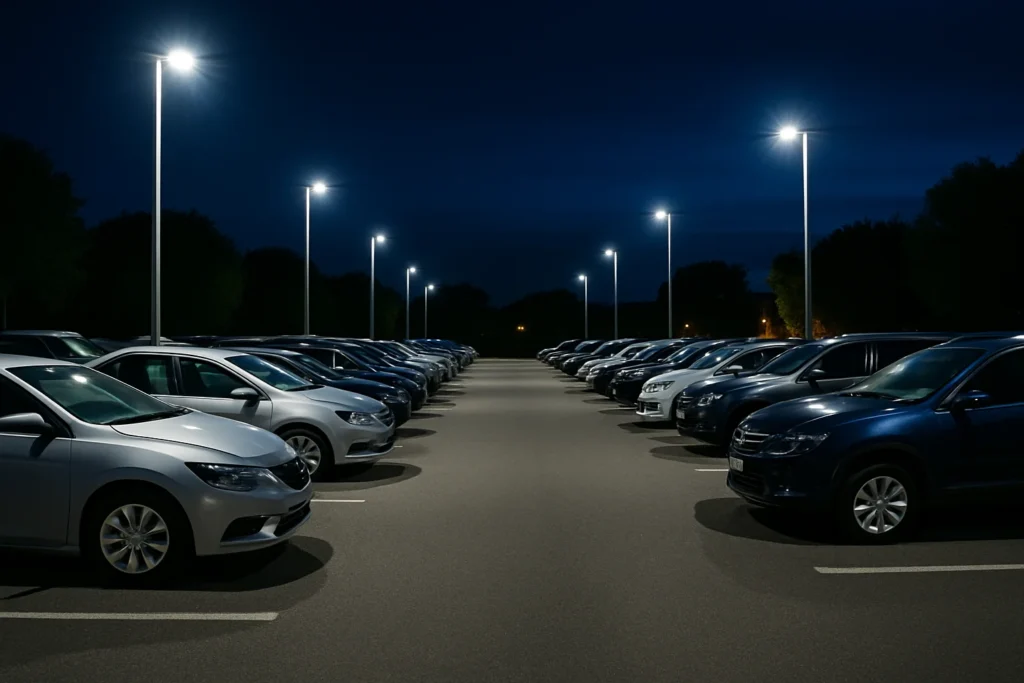
Most auto crimes happen under the cover of darkness. This makes lighting not just a utility concern, but a primary deterrent. Commercial properties must prioritize lighting across the entire parking lot, including remote corners and behind structures where vehicles are often parked. LED lighting with wide coverage is preferred, not only for energy efficiency but also for its brightness and reliability.
Motion-activated lighting can help startle would-be criminals while also drawing attention to unauthorized activity. Furthermore, businesses should keep landscaping trimmed and avoid placing large decorative features that obstruct views or create hiding spots. A clear line of sight across the property enables both human surveillance and camera systems to be more effective.
It is also helpful to evaluate visibility from adjacent roads and buildings. A lot that is clearly visible to passing traffic is less likely to be targeted. In contrast, lots surrounded by tall fences or buildings with no visual exposure are prime locations for unnoticed criminal activity.
For extra deterrence, install signage warning of surveillance and security patrols. Even if a criminal believes there may be security present, they are statistically less likely to take the risk. The appearance of security can be almost as valuable as the tools themselves when it comes to deterrence.
Security Personnel: The Human Factor
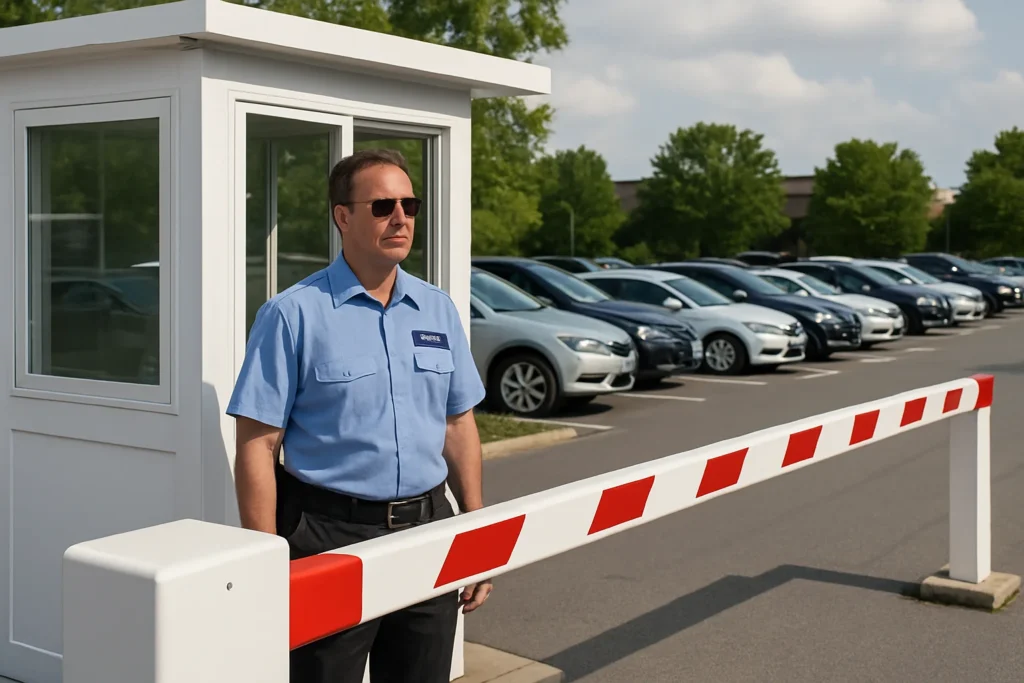
While technology plays a vital role, the presence of trained security personnel adds an irreplaceable human layer of defense. Mobile patrols, especially those that are randomized in timing and route, serve as a powerful deterrent. Criminals are less likely to strike a property that they perceive to be actively monitored.
Security staff should be trained not just to observe and report, but to take preventative actions within the limits of the law. These may include intervening in suspicious activities, checking the perimeters, ensuring all access points are secure, and maintaining a visible presence during off-hours.
Businesses can also partner with professional security firms offering services tailored to commercial lots and auto-heavy environments. These services often include patrol logs, incident reporting, and even bodycam footage to assist in investigations if an incident does occur.
In high-crime areas or in cases involving repeated targeting, some companies employ K9 patrols or off-duty law enforcement. This represents a higher upfront investment but offers unmatched deterrent value and rapid response capability in emergencies.
Smart Access Controls and License Plate Recognition
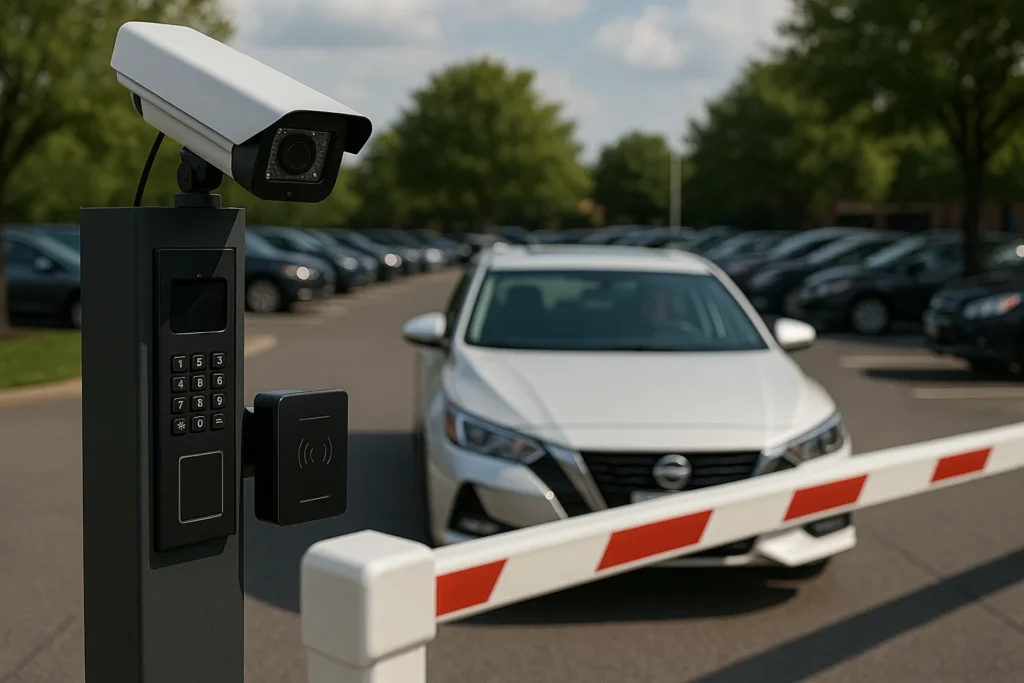
Another layer of control comes from smart access systems. These include RFID cards, key fob access, keypad entry, or smartphone-controlled gates. This ensures that only authorized staff or customers are able to access the lot, especially after hours.
License Plate Recognition (LPR) systems are increasingly being adopted in high-risk environments. These systems can automatically log all vehicles entering and exiting a lot, and instantly flag plates that are stolen or suspicious. Integrating LPR with your surveillance system allows for fast response times and can greatly assist in criminal investigations.
As an added benefit, access systems can provide detailed logs that prove invaluable in legal disputes or insurance claims. Knowing precisely who accessed your facility and when gives you a timeline to work with if an incident occurs.
Insurance and Legal Considerations
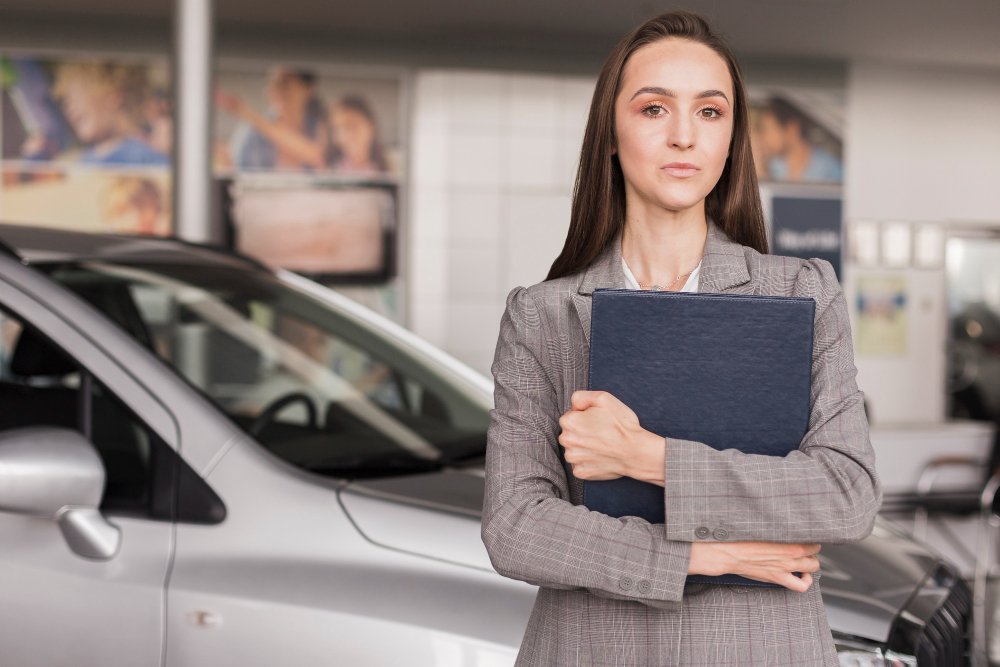
It’s important for property owners to work closely with their insurers to understand what coverage is provided for parked vehicles—especially if they are customer-owned. Some policies may have exclusions or limited payouts for certain types of theft or vandalism. Regular risk assessments and documentation of all security upgrades can help in negotiating better insurance terms.
Additionally, if a lack of proper security results in a customer’s property being stolen or damaged, businesses could be exposed to legal liability. Clear signage, visitor policies, and disclaimers should be visible to limit this exposure, and all policies should be reviewed by legal counsel to ensure proper coverage.
Implementing waiver clauses during vehicle drop-off or in service contracts may help shift certain responsibilities, but only if your security systems are demonstrably reasonable and effective. Legal counsel should review your liabilities periodically as security technology and legal standards evolve.
Collaborating With Law Enforcement and Community Initiatives
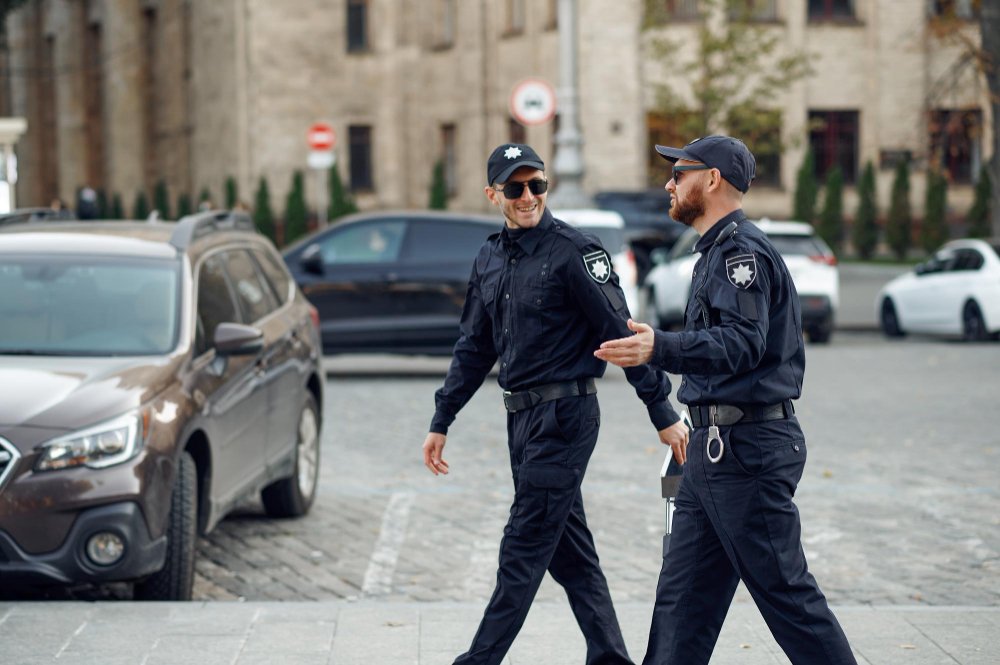
Proactive engagement with local law enforcement can make a significant difference. Businesses should share their security plans with police and request regular patrols in high-crime areas. Some jurisdictions offer crime prevention audits or CPTED (Crime Prevention Through Environmental Design) evaluations for commercial lots.
Participating in business watch or neighborhood watch programs can also be beneficial. Sharing information about suspicious activity, patterns of theft, or new criminal tactics with nearby businesses can improve everyone’s security posture.
Another underutilized approach is to invite police to use your lot during breaks or to complete paperwork. This brings a constant presence that deters crime while building rapport with local officers.
Responding to Incidents: Have a Plan
Even with strong preventative measures, no system is completely foolproof. That’s why businesses must have a clear protocol in place for responding to incidents. This includes notifying authorities, preserving video footage, securing the scene, and notifying affected parties.
An incident response plan should designate key personnel, outline steps to take in the event of a breach, and be reviewed and tested regularly. Having a professional and timely response can reduce losses, support successful prosecution of perpetrators, and show insurers that your business takes security seriously.
Some businesses go further by preparing media statements or customer communications in advance, so they’re not caught flat-footed in the event of a viral security incident. Speed, transparency, and professionalism matter immensely in the digital age.
Future-Proofing: Adopting a Culture of Security
The best way to stay ahead of auto crime is to adopt a mindset of continuous improvement. As criminals become more sophisticated, so too must your security protocols. Regularly review your security infrastructure and look for opportunities to upgrade. Embrace new technologies such as drone surveillance, AI detection, or smart fencing as they become viable.
Train your staff to be vigilant, make security a regular agenda item in operations meetings, and empower everyone in your organization to report concerns. Culture change starts at the top—when leadership prioritizes security, it becomes part of the organization’s identity.
Engage with technology providers and attend industry conferences or workshops to stay ahead of the curve. What worked five years ago may now be obsolete in the face of evolving threats. Security is a moving target—only businesses that adapt quickly will stay protected.
Prevent Auto Crime in Commercial Parking Lots Conclusion
Protecting parking lots from auto crime isn’t just about avoiding theft—it’s about preserving the integrity and operational capacity of your business. Car dealerships, service centers, and commercial lots face unique risks due to the high volume and high value of unattended vehicles. By investing in layered security systems, fostering strong relationships with law enforcement, and maintaining a proactive mindset, business owners can significantly reduce the likelihood and impact of auto crime.
Prevention is always less expensive than recovery. Taking action today protects your business tomorrow. More importantly, it protects your people, your reputation, and your ability to serve your customers without interruption.
